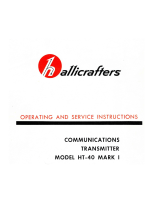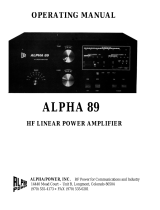
I IV{'IEL
4OO TRANSCEIVER
A. C
i.cuit Theory
(Cont)
The single sideband, suppressed carrier At the sarne tirne,
one d€flection
plate of
signal Jrom the First IF Amplilier
is fed the balanced rnodulator is grounded, un-
to
the Transmitter Mixer, V2, u'here balancing
the modulator and allowing full
signals
Irom the VFO Amplifier are
carrier input for tuning
puiposes,
A
mixed,
and the resultant signal
at
the
similar
procedure
is followed in the CW
final
transmitted frequency is alnplified
position
of the Phone
-CW
switch,
to
allow
through
the Transrnitter
Mixer,
the
full carrier
output
duiing
CW operation.
Driver,
V3, and
the Power Amplifiers,
During
CW
operation the cathode of V168
V4 and V5.
The signal from the
VFO
i6 opened from grotrnd, cuttrng ofI the
Amplifier iE initiated in the
particular
tube.
This
allows CW
operation with no
Frequency Control Unit being
used. The danger
of pickup of
audio
through an open
signal frorn the Frequency Control Unit
microphone, Attempts to operate
on
CW
is routed to the VfO Amplilier, and
on by keying the lnicrophone
jack,
and
insert-
40 and 80 rneteis,
is
subtractively
ing
carrier,
are
not recommended.
mixed with the single sideband signal
from
the
IF
AmpliIier. On
20,
15, and RECEM
l0 meters, the frequencies are additively
mixed, resulting in
output on the opposite In RECEIVE
position, or
at
any time when
sideband,
the transrnitter is not in TRANSMIT
or
STANDBY, all
circuits used in transmitting
When in TRANSMIT,
thc
gain
oI the First
are disabled throrgh the
relay controlled
II Amplifier
is controlled
through the
circuits, thc relays being energized Ior
Automatic
Limiting Control network
transmitting, and de-energrzcd
for receiv-
D40l-402,
etc., to control the
gain of ing. Rclay K2, when de-energized, allows
the stage in response
to the
average
in- signals
frorn the transrnitting tank circuit
put power to the
power
amplifiers. This and
antenna to be ted to the Receiver RF
ALC system will
cornpensat€ {or any Amplifier, V6,
where thcy are amplilied,
extremely strong
input signaLs, but does
and then {ed to the control
giid
oI
the
not completely
eliminate the necessity
of
Receiver
Mixer,
V?.
The local
oscillator
proper
adjustrnent
ol the Mic. Gain
signal from the
VFO
Amplifier is
now
Control.
Although
this feature wil] used
to heterodyne the received frequency
prevent the transmitter Jroln flat-topping
to the IF frequency,
either upper or
lower
and spurious
ernissions, considerable sideband.
A11 IF arnplification is
distortion
may
occur if the Mic.
Gain
accomplished at this Jrequency, nominally
control
is not
properly
adjusted. Refei 5l?4.5
kc,
and
in the Product Detector
to Operating Instructions.
Vl0A, the IF lrequency is heterodyned
with
carrier frequency
generated
by
TUNE AND CW OPERATION
Carrier Oscillator, VI5, to
res$lt
in
detection of the sarne sideband used to
Normally,
the Jrequency oJ the carrier
generate the transmitted signal. It i6
oscillator
is approximately 300 cps out- thus
not possible {or the transceiver to
side the
passband of the crystal lattice receive a 6ignal on any frequency
other
filter. In TUNE
position,
to enable the than that to which the trarlsrnitter is tuned,
transmitter
to be tun€d to the maximum nor to detect the wrong sideband. This
power output condition,
the frequency of simple single conversion de6ign results
the carrier
oscillator is moved approxi- in an extrelnely
stable signal, and an
mately 500
cps to
place
it well within image
response down more than 80 db.
the
passband ofthe
cry6tal lattice filter,
Since
the
VFO
frequency from the






















